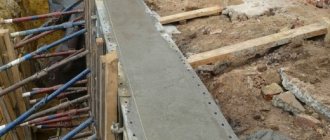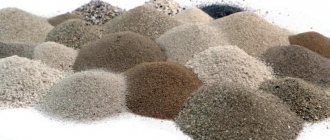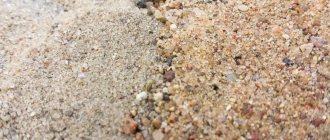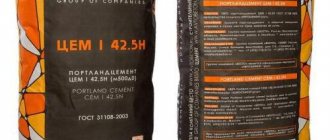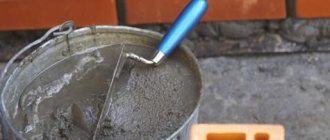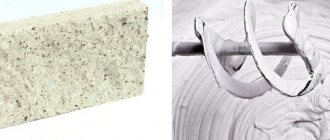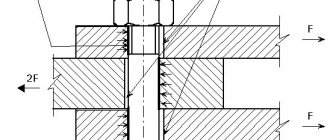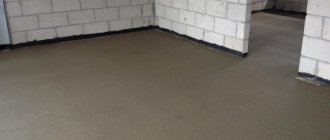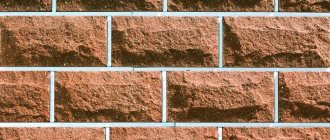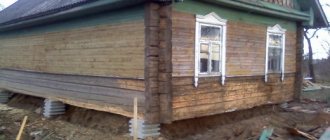Updated: 04/22/2021 16:53:16
Expert: Andrey Nikolaevich Kuznetsov
*Review of the best according to the editors of expertology.ru. About the selection criteria. This material is subjective in nature, does not constitute advertising and does not serve as a purchase guide. Before purchasing, consultation with a specialist is required.
Not a single construction site today can do without such an important material as cement. Every year, manufacturers improve manufacturing technologies and modernize equipment, which leads to the creation of high-quality compositions. The scope of application of the product is very wide; the material is used not only on construction sites, but also in other industries. Therefore, each case requires cement with a certain set of characteristics. Before you head to the store or place an order online, you should listen to the advice of experts.
Cement rating
The main characteristics of cement mortar are binding ability and strength after hardening. To improve these parameters, manufacturers use different raw materials, additives, and additives. The VyborExperta.ru team decided to find out which building mixtures meet the declared characteristics. Experts performed testing using instrumental methods of initial compositions, checked the quality of mortars and concrete, and analyzed the dynamics of strength gain. When compiling the review, the opinions of professional builders, architects and designers were taken into account.
The main attention was paid to the following parameters:
- Composition – determines the technical characteristics of structures after hardening, the scope of application of the material;
- Strength – determines the ability to withstand a certain pressure. Products are produced with different grades of strength, the basis of the plant’s assortment is cements of the M400 and M500 classes;
- Cleanliness - the amount of additives affects performance characteristics, hardening rates, and comfort level during use;
- Speed of strength development - the rate of hardening affects the progress and technology of work;
- Shelf life – cement, by construction standards, is a perishable product. The material must be used no later than 3-6 months after the production date.
Not all products corresponded to the declared passport data and current SNiPs. Compositions with insufficient strength, a large amount of impurities, and low adhesion of the solution to mineral substrates were excluded from our rating.
The best concrete mixers
Determination of binder quality
Being informed about the technical characteristics of the binder component is not enough to make the right choice about which cement is best. It is important to be able to determine the quality of the powder, which can change for the worse depending on the conditions and shelf life of the product.
Various cements Source beton-cement-ru.ru
The best cement brand M400
The low price of M400 cement, good binding properties and prevalence have made this brand the most popular on the market. The building material is used to create mortars for brickwork, plastering facades and interior walls, screeds in the construction of private houses, high-rise buildings, and commercial real estate. Cement is used in the production of ready-mixed concrete. Our experts tested the products of 8 factories and chose 3 brands that comply with current GOSTs and standards. The use of these building materials will not lead to excess consumption of the binder.
Rusean NC-20
The prestressing cement from the plant, located in the Moscow region, is intended for the construction of moisture-resistant structures. The solution has the ability to expand during hardening, providing maximum waterproofness. The binder is used for sealing tanks with petroleum products, eliminating cracks and leaks in hydraulic structures and drainage systems. A solution based on NTs-20 is used when performing repair work in basements, garages, and car washes.
The mixture corresponds to water resistance class W10, frost resistance – F50. When making the solution, it is recommended to mix it with sand in a 1:2 ratio. Apply by hand and machine. Supplied in bags convenient for transportation, weighing 25 kg.
Advantages:
- Resistance to petroleum products;
- Improved adhesion to mineral substrates;
- Tolerates extremely low temperatures;
- High bending strength;
- Compensates for volume changes due to shrinkage.
Flaws:
- It is required to wet the structure for 7 days after application.
Tension cement cannot be mixed with other grades of Portland cement, and compaction is required when laying the mortar. Compliance with the technology will help increase the strength and durability of the structure, without reducing gas permeability.
Stone Flower
Produced in the Moscow region, it is intended for creating non-shrinking solutions. It is recommended for manufacturers of paving slabs who use vibration casting and vibrocompression methods in the technological cycle. A ready-to-use composition with coarse sand, requiring only mixing with water. It is used when pouring screeds on residential and basement floors, and arranging wear-resistant floors in industrial premises.
After mixing, the viability of the solution reaches 120 minutes. The ready-to-use composition is characterized by low consumption. Supplied in durable, four-layer paper bags, weighing 40 kg.
Advantages:
- Good elasticity of the finished solution;
- Rapid strength gain;
- Low price;
- Frost resistance 100 cycles;
- Increased resistance to abrasive effects.
Flaws:
- Limited scope.
Eurocement CEM II/A-Sh 32.5N
The products of Russia's largest manufacturer are produced at three factories equipped with high-tech equipment. Quality control of raw materials and all stages of production allows us to produce a binder that meets the requirements of GOST. A feature of this brand of cement is the presence of additives and slag, in a volume of 6 to 20%. The mixture belongs to the category of normally hardening solutions.
Cement is used for laying bricks and natural stone, pouring foundations and screeds, and for preparing mortars. It is used for the production of concrete class B7.5-B30, which is intended for civil and industrial construction. Supplied in durable paper bags of 50 kg.
Advantages:
- Increased frost resistance;
- Accelerated strength gain;
- Resistance to cracking;
- Self-compensation of the expansion process;
- Low price.
Flaws:
- Not detected.
Component proportions
Concrete mortar for large construction projects is made in factories, but for small enterprises and private owners, the best way to pour the foundation is to independently produce a cement mixture: sand, crushed stone and water with cement.
The components must meet the requirements: sand must not contain clay particles, its fraction is from 1 to 2.8 mm; crushed stone with a particle size of 1-2 cm, and only clean water, without any impurities.
Mixing proportions depend on the required strength of concrete and grade of cement. Weight ratios C:P:SH:W for binder M400:
- 1:4.5:7:0.5 for monolith M100;
- 1:2.8:4.8:0.5 is used for grade M200;
- 1:1.9:3.7:0.5 to get strength M300;
- 1:1.2:2.7:05 for M400 concrete.
Proportions of components.
The proportion for preparing the M200 mixture should be 1: 2.8: 4.8: 0.5. This means that to mix 1 m³ of concrete you will need: M400 cement - 263 kg, river sand - 738 kg, crushed stone or gravel - 1265 kg, water - 131 liters.
The best cement brand M500
The cost of M500 cement per kg is higher than that of M400, but this is compensated by its high strength, resistance to cracking and durability. This type of binder is recommended for pouring foundations and load-bearing structures. The M500 is used when working at critical facilities, in the production of concrete. We offer products from 4 factories, which are characterized by stable quality, good adhesion and compliance with the declared characteristics.
Holcim Extracem 500
Produced by LafargeHolcim, a world leader in the volume of dry building mixtures produced. Innovative “dry” technology is used in production. The quality meets the requirements of GOST, is characterized by a homogeneous composition and good cohesion. The cement is intended for manual and machine pouring of foundations, arrangement of floor screeds and laying of load-bearing structures.
The high demand for construction materials from the LafargeHolcim holding guarantees the use of fresh cement in the work. Solutions based on it are plastic and have minimal shrinkage. Supplied in durable bags weighing 50 kg. According to consumer reviews, the mass of products always corresponds to the stated figures.
Advantages:
- Good water-retaining properties without special additives;
- Do not cause corrosion of reinforcement;
- Excellent adhesion to metals and mineral substrates;
- High quality waterproofing;
- Short setting time.
Flaws:
- Not detected.
De Luxe CEM I 42.5
The products are manufactured and are of stable quality. Solutions based on it are used in frame-monolithic housing construction for structures with increased strength requirements and road construction. The composition is recommended for the construction of reinforced concrete products exposed to constant contact with aggressive substances.
The manufacturer produces building mixtures from this brand of cement, which provides the products with the necessary frost resistance, strength and elasticity. Packaged in durable multilayer bags weighing 50 kg.
Advantages:
- Good water resistance of structures;
- Resistance to temperature changes;
- High adhesion to reinforcement and mineral bases;
- Fast hardening;
- Durable bags.
Flaws:
- Overcharge.
Portland M-500
The brand was developed for producers of dry building mixtures and ready-mixed concrete. Recommended for the construction of facilities with increased requirements for structural strength. Provides an increase in the service life of products and structures. The products can be used when pouring foundations and cement-sand screeds.
The solution based on Portland M-500 has good plasticity, despite the absence of plasticizers in the composition. This is achieved by the high quality of the clinker used. Packaged in multi-layer bags weighing 40 and 50 kg, which allows you to choose a packaging that is convenient for transportation and storage.
Advantages:
- Low price;
- Good crack resistance;
- Gains strength of 19 MPa already on the second day;
- Resistant to critical temperatures;
- The structures have good moisture resistance.
Flaws:
- Not detected.
Siberia D20
It is made from low-iron clinker with the addition of additives. Used in the production of building mixtures and reinforced concrete structures. Recommended for products that have increased requirements for frost resistance and water absorption. This material can be used to produce sleepers for railways and power line supports. Professionals speak well of solutions based on this cement, used in emergency and restoration work.
When pouring foundations, high plasticity of concrete is noted. Setting begins 90 minutes after mixing. Strength development proceeds quickly, reaching high characteristics by the end of the second day after pouring.
Advantages:
- Resistance of structures to temperature changes;
- Good quality bags;
- Accurate weight;
- Minimum water absorption;
- Low price.
Flaws:
- Bags are only one weight.
Price and manufacturer
Most often, the difference in the cost of cement is determined by the accuracy of packaging. The best option is cement in bags. The production of this building material in bags is carried out abroad and in the CIS at specialized bases, in specialized construction supermarkets or directly at a cement plant. On the other hand, it is much more profitable to buy cement in bags compared to loose cement, and it is easier to store it.
Any manufacturer that deserves attention and respect packages its product in bags that indicate its own address and telephone number, as well as the accuracy of weighing. Typically, a good supplier is considered to be an authoritative and well-known figure in the market who values his clients and his reputation. If there is no information about the manufacturer on the bag, then you need to be personally acquainted with the packers in order to buy such a product with confidence.
And finally, remember that the price of cement, which depends on the brand of cement, is not always a guideline. The modern construction market is rich in fakes; for example, unscrupulous manufacturers in recent years have been practicing reducing the concentration of cement dust to reduce prices for their products, which subsequently leads to poor quality cement mortar, which is not able to retain moisture and can crumble immediately after construction is completed. . Therefore, you should focus not on price, but on the reputation and guarantees of the supplier.
The best cement brand M600
It is recommended to buy products with the M600 brand for the production of reinforced concrete structures. This cement should be chosen only for critical objects. Sculptors use this material when creating monuments, memorial complexes, and complex small-scale architectural objects. Our team recommends three brands of products that stand out for their high quality, stable performance and balanced price.
Cimsa
White cement manufactured by a Turkish company that has extensive experience in the European market. It is produced using a high-tech “dry” method and has high performance characteristics. It is recommended for manufacturers of finishing facade plasters due to its ability to form a perfectly smooth surface. The minimum percentage of whiteness is 85%.
The products are characterized by high uniformity of composition, this helps to form a cement stone with a structure that prevents destruction under the influence of temperature changes. The mixture can be used in the production of decorative bricks, artificial stone, colored concrete and self-leveling industrial floors.
Advantages:
- Resistance to solar ultraviolet radiation;
- Inertness to the effects of organic compounds;
- Protects fittings from corrosion;
- Resistance to cracking;
- Low alkali content.
Flaws:
- High price.
Akkermann
Made from pure cement clinker, it is very finely ground. Designed for the production of high-strength ready-mix concrete grade B30 and higher. Can be used in the production of paving slabs, curbs, and products for facade cladding. Good cement for floor screeds in commercial and industrial buildings, non-autoclaved aerated concrete blocks.
The solution is plastic, sets well and quickly gains strength. The mixture can be used for repair work, construction of bridges and arched structures. Finished products are characterized by reduced fragility and resistance to temperature changes. Packaged in durable bags of 25-50 kg.
Advantages:
- Uniform light gray color;
- Increased moisture resistance;
- Exact weight in each bag;
- Low consumption per cubic meter of solution.
Flaws:
- It is recommended to carry out work at above-zero temperatures.
Adana
The products of the young Turkish company are distinguished by a high degree of whiteness, which reaches 90%. It is produced using “dry” technology and has a fine grind, which makes the finished solution homogeneous and as plastic as possible. The mixture is mobile and easily fills cracks and crevices, which allows the material to be used for emergency and repair work.
The manufacturer recommends its product for the production of self-leveling floors, finishing facade plasters and colored concrete. This is a high-quality raw material for artificial stone, floor tiles, and gardening architectural forms. The material has high adhesion to mineral substrates.
Advantages:
- Low alkali content;
- High speed of achieving strength;
- Suitable for restoration work;
- Withstands sudden temperature changes.
Flaws:
- High price.
Special
By adjusting the composition, adding mineral and organic substances to it, it is possible to obtain special grades from ordinary cement. Let's list just a few of them:
- Plasticized. Thanks to the introduced surfactant plasticizers, it is characterized by workability, thixotropy, corrosion resistance, and density. Found application in the construction of hydraulic structures and roads.
- Hydrophobic. It is characterized by hygroscopicity, which simplifies the process of storing cement in humid conditions. Commonly used for cladding exterior facades of buildings.
- Straining. A quick-setting mixture that expands as it hardens. It is used where strict requirements for waterproofing, resistance to cracks and fractures are established.
How to choose cement
What general construction material is needed to implement the plans? The VyborExperta.ru team offered the best brands in each category, but what to do if the products are not on the market. In this case, it is necessary to pay attention to the strength grade, composition, and hardening time of the proposed mixtures. All the necessary information is contained on the bag in which the cement is packaged. There is also information about the shelf life and production date. The information will help you choose a building material that will correspond to the operating conditions of the structures and the planned loads.
Compound
The main raw material in the production of general construction materials is clinker, which is prepared from a mixture of limestone and clay. These substances are sintered at a temperature of 1450 degrees into granules and ground with a small amount of gypsum or calcium sulfate. These additives regulate the rate of setting of the solution. The composition contains several silicates, the main share being alite. The more it is, the better the cement interacts with water during mixing, the more active and stable the strength is gained. Products with a high alite content are called Portland cement - this is the best choice for general construction work.
For special work, it is necessary to choose special brands that differ greatly in their composition. Acid-resistant cement contains a large amount of sodium hydrosilicate, while quick-hardening cement contains a predominant amount of aluminate. When working with wood, magnesium cement is used, which has good adhesion to this base.
Purity
Products can be made from pure cement clinker, but various additives are used to improve the characteristics of the mixture. This cement is marked with the letter D, the number after which indicates the amount of additives as a percentage. Portland cement D20 contains 20% slag, plasticizers and other additives that improve the plasticity of the solution, increase frost resistance and water resistance.
Products marked D0 do not contain additives. This must be taken into account when performing work. Solutions without additives quickly gain strength in the first stage of hardening and require wetting. This characteristic is relevant when performing masonry work. Mortars with additives have noticeable shrinkage; when pouring formwork, it is necessary to use vibrators to compact the mixture.
Strength
Strength is the most important indicator for masonry mortar, reinforced concrete structure or paving stones. Cement manufacturers mark their products - M400, M500 and M600 are strength grades. The characteristic is conditional: the numbers M400 indicate that a product or masonry made of this material will withstand a pressure of 32.5 MPa. These are high indicators, exceeding the corresponding characteristics of brick by 2-4 times. The product with the M400 brand is intended for masonry, plastering, and floor screeding in private homes.
The design load for M500 is 42.5 MPa, this allows the product to be used in the manufacture of high-strength concrete, screeds at commercial and industrial facilities, and in the construction of foundations for highways. The load for M600 is 52.5 MPa, cements of this brand are called “military”. The products are used in the implementation of complex, critical projects.
Hardening time
The lifetime of the solution varies from 60 to 120 minutes. This affects the speed of production of the finished mixture. The construction manager must consider the time it takes for a crew to complete a job with one batch of mortar. Mixtures prepared from cement marked CEM I harden the fastest. For general construction work, it is recommended to use mixtures of the CEM V class.
When performing emergency work, mixtures are needed that harden as quickly as possible. Such solutions are prepared from cement, the marking of which indicates the letter B - quick-hardening. Working with these compounds has specifics: for a uniform, stable increase in strength, they need to be moistened for 2-7 days.
How to find out the quality of a cement mixture and determine its correct brand
There are several basic rules, following which you can make the right decision and choose normal cement. Before purchasing, be sure to examine the packaging in which the cement is packaged. All operational properties of this material must be printed on the packaging material. Namely: weight, brand, manufacturer, etc. If you buy cement in bulk, you may end up with a low-quality or expired product; you need to be very careful with this and, if possible, inspect each package. Ask the seller or see for yourself how and where the cement was stored, because this material is greatly influenced by the environment, especially dampness. Always look at the manufacturer, especially the country and city where the cement was produced.
770
Which cement is better
Comfort during work and the service life of a building, bridge or hydraulic structure depend on the choice of the main general construction material. Our team selected the best blends in different categories, but did not find a universal one. We recommend purchasing materials taking into account the work being performed and the requirements of the designers. Our advice will help you figure out which cement is better among the offered brands. Experts recommend:
- Rusean NTs-20 – for repair work and construction of tanks for petroleum products;
- Eurocement Tsem II/A-Sh 32.5N – for preparing masonry mortar, mixtures for pouring floor screeds in residential buildings;
- Holcim Extracem 500 – for the production of ready-mixed concrete and pouring foundations;
- De Luxe Tsem I 42.5 – for the production of paving stones and paving slabs;
- Cimsa - for restoration work and the production of white dry building mixtures;
- Akkermann - in the construction of bridges and arched structures.
If you follow the technologies recommended by the mixture manufacturers, the use of these mixtures will give the best results.
Mixing concrete
Small volumes of concrete mixture are prepared by hand using an old trough or bathtub. First, add cement and sand, mix until smooth, add water and repeat the procedure. Lastly, crushed stone is added.
By using a concrete mixer, the speed of concrete production increases.
Mechanized mixing involves performing operations in a prescribed sequence. After starting the drum, the components are gradually added:
- cement and a small amount of water - until uniform mixing is achieved;
- sand is poured in small portions;
- Little by little crushed stone is added to the almost finished mixture, and water is added if necessary.
For ease of use, a bucket is used as a measuring vessel. To fill the foundation with a concrete mixer, mix 2 parts of cement and crushed stone, 6 parts of sand. It is difficult to work with a thick concrete solution; it can be diluted a little. But there shouldn’t be a lot of water: the strength of the monolith is lost.
The cement mixture sets in 10-12 hours, and hardens in a week. Full strength is gained a month after pouring at a temperature of 20ºC.
Appearance
A good product can be identified visually. If the Portland cement in the photo has a marshy, yellowish tint, then this is a sign of not the best raw material. Let us clarify that we are talking only about “pure” cement without additives.
When meeting someone in person, you can take a handful in your hands - when squeezed, the good cement mass will definitely pass through your fingers.
Mordovcement
Cement M500 “Mordovian” is the most popular brand in the production of a wide range of construction works. The largest JSC Mordovcement produces cement in the amount of 3,450,000 tons annually. The enterprise is equipped with equipment from the American corporation General Electric, the German company FAM, the Finnish MEKA, etc.
Among the advantages of M500 cement from Mordovcement:
- ease of installation;
- fast curing;
- frost resistance;
- moisture resistance;
- high degree of strength;
- durability;
- environmental cleanliness.
According to experts and consumers, M500 “Mordovcement” is an excellent alternative to cement from other manufacturers. Excellent quality, a real monolith!
